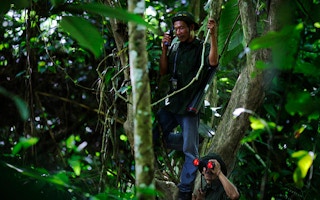This is the first of a two-part series exploring the linkages between carbon finance and peace-building.
Liberian environmentalist Silas Siakor knows all too well what can happen to a fragile nation when a dictator hijacks its commodity sector, as warlord Charles Taylor did in the 1990s – first by using slave labor and “blood diamonds” to finance a devastating civil war in neighbouring Sierra Leone, and then by spreading that war to Guinea and commandeering the presidency of Liberia itself.
Siakor helped expose Taylor’s use of “conflict timber” to finance those bloody wars, and he helped make sure farmers, conservationists, and commercial enterprises all had a role in restructuring the forest sector once the sanctions were removed – a process that Art Blundell, who chaired the UN Panel of Experts on Liberia, credits with keeping the country’s current peace alive.
He cautions, however, that Liberia’s peace is the exception that proves the rule.
“The UN Environment Programme says that natural resources are a factor in about 40 per cent of conflicts since the end of the Cold War, and they are often a driver,” Blundell said at last month’s Oslo REDD Exchange in Norway, where he presented findings from recent analysis conducted on behalf of Ecosystem Marketplace publisher Forest Trends. “But if you look at peace agreements, only about 15 per cent of them mention natural resources, let alone call for reforms of governance in a way that will minimise the role of resources in causing future conflict.”
The result, he said in a recent episode of the Bionic Planet podcast, is tragic: “More than half of peace agreements fail within five years, often because belligerents get money from the exploitation of natural resources, like logging, that they can use to fuel the resumption of civil war.”
“
Natural resources are a factor in about 40 per cent of conflicts since the end of the Cold War, and they are often a driver.
Art Blundell, chair, UN Panel of Experts on Liberia
Liberia has so far avoided slipping back into that cycle, in part because it tore up corrupt concessions and started with a clean slate on forest governance. That peace, however, has a downside of its own: without civil war, the forests are now safe for illegal logging – which is often carried out not by ruthless logging companies, but by desperate farmers looking to feed their families.
As the government steps in to save forests, it risks pitting conservationists against small farmers – something Siakor says has already happened.
“The government has tried to impose [conservation] projects on the people – in protected areas – but people have resisted, and they’re very active in this resistance,” he said at the Oslo REDD Exchange. “The government had to roll back [its conservation efforts] and grant the community the right to manage that particular forest.”
Siakor sees a more workable solution in President Ellen Johnson Sirleaf’s efforts to tap carbon finance through the United Nations REDD+ (Reducing Emissions from Deforestation and Degradation of forests, plus other land uses) initiative, which aims to slow deforestation by funding sustainable agriculture initiatives so that farmers aren’t forced to chop trees – a process that aligns the interests of small farmers with those of the forest and also promotes the kind of governance associated with lasting peace.
Such initiatives have proven successful in several Latin American and African countries, and forest-carbon projects are currently being used to conserve forested areas larger than the entire Democratic Republic of Congo, according to the most recent State of Forest Carbon Finance report. Both Siakor and Blundell say that REDD+ can support the peace process in war-torn areas, but only if its implemented in ways that recognize the challenges particular to war-torn regions.
“REDD programs working in the countries have to remember that people have been traumatised,” said Blundell, adding that traumatised people are slow to develop trust. “You have to understand the history of the conflict, the legacy of that conflict in the present, and your interaction with it.”
This story has been adapated from the Bionic Planet episode “Climate, Conflict, and Commodities: The Calculus of Peace on a Changing Planet” and was published with permission from Ecosystem Marketplace.
Read the rest of the story here.










